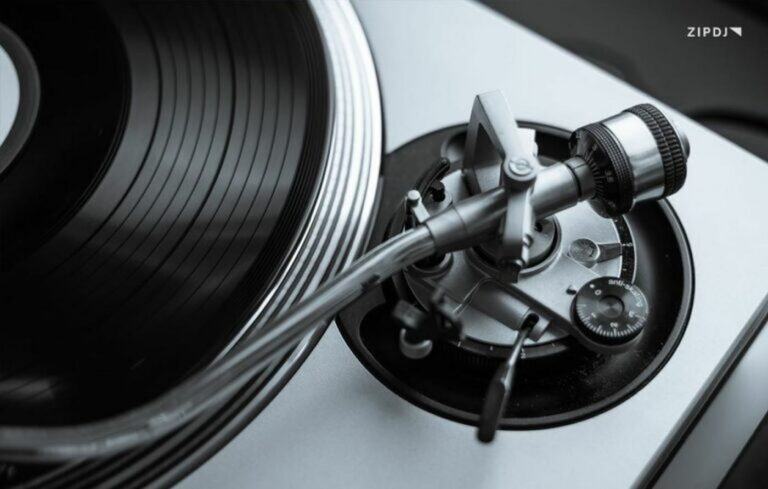The History of Record Players And Turntables (A Detailed Guide)

The history of turntables and record players provides a fascinating insight into how technology has evolved to become what it is today.
Beginning in the mid-nineteenth century with the phonautograph, the record player has transformed with technological advances to deliver superior audio quality.
With the sale of records continuing to climb and DJs regularly turning to the format for their sets, there’s no sign of it becoming a thing of the past.

History of Record Players & Turntables (A Detailed Guide)
Record players have reshaped the way people listen to music over a century of development, as well as defining the role of the DJ in clubs and bars.
We’ve covered the early origins of the format, how its evolution has impacted the music industry, and how DJs perform.
So, with our criteria established, here’s everything you need to know about the history of record players and turntables:
The Invention Of The Record Player
The history of record players began in 1857 in France, courtesy of the French bookseller and inventor Edouard-Leon Scott de Martinville.
Patented on the 25th of March, the phonautograph became the earliest known sound recording device and would pave the way for the record player.
While the phonautograph didn’t record and replicate audio, it transcribed sound waves into a visual pattern that could later be studied.
The process placed the recorded sound on a line traced on smoke-blackened paper or glass.
Intended as a laboratory experiment for studying acoustics, it allowed people to determine frequencies and compare musical pitches.
While the phonautograph has huge historical significance, its impact was minimal at the time of its creation, and Edouard-Leon Scott de Martinville died before his genius was recognized.
As we continue to live through exciting times and the emergence of new and innovative DJ technology, it’s instructive to reflect on where it all began.
Thomas Edison & The Phonograph
The evolution and history of record players took new and exciting leaps with the advent of the phonograph, designed by Thomas Edison.
Edison’s phonograph was invented in 1877 at the height of electric signal technology innovation, recording sound and playing it back.
This revolutionary technological advancement worked by inscribing audio on a tinfoil sheet wrapped around a cardboard cylinder for playback.
Another luminary of the age, Alexander Graham Bell, took Edison’s phonograph and replaced the tin foil outer layer with wax cylinders to record sound waves at a higher quality.
Additionally, Bell replaced the rigid needle with a floating stylus, creating superior sound quality in the process.
This led to the emergence of two competing companies, the American Graphophone Company and the Volta Laboratory, although ultimately, neither became the industry standard.
That honor would go to Emile Berliner, whose contribution to the evolution of the record player was to be the most lasting of the era.
Emile Berliner & The Gramophone
While both Edison and Bell used a cylindrical model for their sound reproduction, Emile Berliner etched the recordings on flat discs.
This decision paved the way for what we know today as the vinyl record, which used to play music in the twenty-first century.
It was Berliner who dubbed this machine the “gramophone,” securing his patent for the device in 1887 and constructing it from hard rubber and shellac.
The foundation for the contemporary record player, the gramophone, saw the vinyl records attached to a large trumpet-shaped cone where the sound waves emerged.
The basic operation of the gramophone consisted of a mechanical design that caused the vinyl record to spin as a needle reads the grooves.
From the needle, which was typically made of sapphire or diamond, a band of metal links it to the cone via the tonearm.
By 1895, the gramophone was being mass-produced, revolutionizing how people listened to music in an era where live music had dominated.
The Rise Of 78 RPM Double-Sided Records
The mass production of the gramophone coincided with the advent of radio, and the two would work together hand in hand over the following years.
By the early twentieth century, the creation of the double-sided 78 revolutions per minute vinyl records was reshaping the radio industry.
In fact, the advent of the double-sided record format heralded the early days in the history of DJing, widely used throughout emerging radio stations.
Radio commercials could be recorded onto vinyl, and their widespread production allowed casual music listeners to enjoy their favorite artists at home.
Measuring ten inches across, these double-sided flat disc records were sold in increasing volumes over the following years and remain highly collectible to this day.
At the same time, the earlier wind-up record players were being phased out in favor of electricity-powered equivalents with fly-wheel friction discs.
While the radio boom of the 1920s impacted the overall sale of records, this drop was short-lived thanks to the arrival of new home entertainment systems.
Columbia Records & The 12-Inch Record
The next notable step in the evolution of record players came in 1948, thanks to Columbia Records and the 12-inch long playing record.
After years of extensive research and development, this format used 33 1/3 revolutions per minute microgroove for extended playtime.
This allowed people to play music for longer durations, heralding the arrival of the album as we know it today.
As significant in its time as the advent of artificial intelligence in music is today, this allowed middle-class homes to enjoy music in entirely new ways.
While Columbia Records’ attempt at creating another 7-inch microgroove format failed, RCA Victor released their version in 1949 with huge success.
Playing at 45 RPM, the RCA Victor 7-inch records became the industry standard and remained in production to this day.
All that was needed now was a line of affordable record players that would further drive the sales of vinyl records through the mass population.

Mass Produced Record Players
The arrival of mass-produced vinyl record players came in 1955 thanks to the radio company Philco.
The company manufactured and distributed the first portable, battery-powered, all-transistor phonographs to the mass market.
Costing as little as $59.95, they were even able to mass-produce record players that also included a built-in amplifier and speaker system.
The availability of cheap and high-quality record players paved the way for the emergence of the pop music genre, which quickly rose to prominence.
Some of the best-selling music artists have sold millions of copies, with artists like Elvis Presley and the Beatles earning fortunes off the back of the format.
45 RPM singles were particularly successful, used regularly by radio station hosts and sold worldwide in high street shops.
This, in turn, allowed more artists to reach a wider audience who might otherwise have sunk into relative obscurity.
While there were downsides to the technology during this era, new developments would soon emerge and take the evolution of record players in fresh directions.
Dual & The Golden Age Of Turntables
The next big step in the journey of record players came in the 1960s and 1970s with the creation of stereo records for mass consumption.
The advent of stereo playback reshaped how musicians and bands recorded their work for the next generations, superseding the previous mono recordings.
The first stereo turntables were launched in the early 1960s and marked the beginning of the golden age of turntables.
A notable example of this technology, the Apollo Record Players from Electrohome, were a huge hit among the burgeoning class of audiophiles.
These advances in high-fidelity combined without needing a high torque system form the basis of the record players we know and love today.
In fact, the future of DJing is intimately linked to this evolutionary step, with the side motor driving the platter via a rubber belt.
All that was required now to allow for modern DJing to take hold was a new drive mechanism capable of consistent speed with variable pitch controls.
Technics & The Direct Drive Turntable
The advent of the direct-drive turntable transformed the potential of the technology in drastic ways not seen up until this point in time.
The Japanese company Technics led the charge with their direct drive turntables, iterations of their 1970s designs still widely used today.
With the ability to fine-tune the tempo of a given record it opened up possibilities for continuous streams of music on radio shows and in clubs.
It was during this era that the best old-school DJs of all time emerged, introducing the mixing techniques that remain commonplace to this day.
Beat matching, using the mixer’s EQ for transitions, and the birth of scratching all took place during this iconic period in the history of record players.
It’s perhaps no coincidence that this era became known for the proliferation of nightclubs and other venues noted for their vibrant music scenes.
Emerging from disco and soul, the house and techno scenes established a foothold in the cultural mindset that remains firm up to the present day.
Indeed, as we’ll see later, the direct drive turntable remains the go-to technology for many modern DJs who enjoy its tactile and responsive feedback.
Hip-Hop & Turntablism
Whether you’re a hip-hop enthusiast learning how to scratch DJ or prefer dance music, it’s impossible to avoid the impact of turntable technology on the role of the DJ.
By the late 1970s, leading into the 1980s, the art of scratching – otherwise known as turntablism – was transforming the rap music scene in America.
Along with breakdancing and graffiti artwork, turntablism dominated the cultural scenes in New York, Detroit, and other major American cities.
As exemplified in documentaries such as Wild Style and Scratch, this marked the evolution of new and innovative uses of turntables.
A wide vocabulary of scratching techniques emerged throughout this period, with the DMC World DJ Championships attracting widespread attention.
Over the years, notable winners, including DJ Skillz, DJ Cheese, Rock Steady DJs, and Cash Money, pushed the boundaries of what could be accomplished with two turntables and a mixer.
The art of turntablism continues to garner new acolytes to this day, ensuring a vibrant future for the technology in the years to come.
The Vinyl Records Resurgence
It isn’t just hip-hop DJs who swear by turntables in the modern world; in the twenty-first century, there’s been a notable resurgence of vinyl records.
This is reflected in the raw sales figures, with a report from Billboard magazine highlighting a continued growth in record sales over the last seventeen years.
It’s not uncommon for today’s leading singers and producers to release their work on vinyl editions, often selling for a premium price.
While digital audio formats, compact disc releases, and USB recording have all impacted music in various ways, vinyl remains a competitive format.
While in the late twentieth century, it may have appeared as if only hardcore music enthusiasts would support vinyl, the reality has been different.
Music collectors have been increasingly drawn to the tactile appeal of DJing with vinyl, particularly in the world of turntablism and scratching.
Technics continues to manufacture their direct drive turntables, with their earlier models highly sought-after collector’s items.
While digital downloads and DJ controllers also increase in popularity, true audiophiles continue to swear by records for their warmth and depth of sound quality.
Summary
The history and evolution of record players offer a fascinating insight into how a combination of genius and good fortune can radically overhaul culture.
Whereas once people only listened to music in a live setting in bars and music halls, the record player completely democratized the nature of music.
Today, record players remain incredibly popular despite new technological advancements, with vinyl collectors scouring the past for rare releases.
Access an extensive archive of classic music with a ZIPDJ subscription and stay on top of the latest releases and trends.
Not a member ?
Join Today for Unlimited Music Downloads. Visit zipdj.com for more information.



